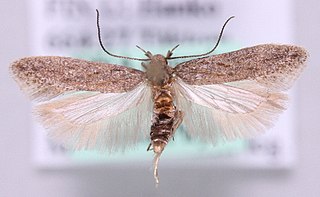Purslane is a common name for several mostly unrelated plants with edible leaves and may refer to:

Halimione portulacoides, commonly known as sea purslane, is a shrub found in Eurasia.
Sea purslane is a common name for several plants and may refer to:

Coleophora versurella is a moth of the family Coleophoridae. It was described by Philipp Christoph Zeller in 1849.

Coleophora atriplicis is a moth of the family Coleophoridae found in Europe and North America.
Coleophora guadicensis is a moth of the family Coleophoridae. It is found in Spain.

Halimione is a plant genus from the subfamily Chenopodioideae of the family Amaranthaceae. It is a sister genus of Atriplex and is included in that genus by Plants of the World Online.

Scrobipalpa atriplicella, the goosefoot groundling moth, is a moth of the family Gelechiidae. It is found from most of Europe throughout Asia to Kamchatka and Japan. It is an introduced species in North America.

Scrobipalpa nitentella, the common sea groundling, is a moth of the family Gelechiidae. It is found in most of Europe, North Africa (Tunisia), Turkey, Afghanistan, Kazakhstan, China, Mongolia and Siberia (Transbaikalia).
Juncus rigidus is a species of rush known by the common name sea rush. It is native to much of Africa and parts of western Asia. It is found inland and by the sea in sandy saline habitats.
Erythrobacteraceae is a bacterium family in the order of Sphingomonadales.
Microbacterium endophyticum is a bacterium from the genus Microbacterium which has been isolated from the plant Halimione portulacoides from the Ria de Aveiro in Portugal.
Microbacterium halimionae is a bacterium from the genus Microbacterium which has been isolated from the salt-marsh plant Halimione portulacoides near the Ria de Aveiro in Murtosa, Portugal.
Altererythrobacter is a bacterial genus from the family Erythrobacteraceae.
Alteraurantiacibacter aestuarii is a Gram-negative and aerobic bacterium from the genus Alteraurantiacibacter which has been isolated from seawater from the South Sea in Korea.
Altericroceibacterium indicum is a gram-negative, rod-shaped and non-spore-forming bacterium from the genus Altericroceibacterium which has been isolated from the rhizosphere from the rice plant Porteresia coarctata in Pichavaram in India.
Altericroceibacterium endophyticum is a Gram-negative, rod-shaped and motile bacterium from the genus Altericroceibacterium which has been isolated from the plant Halimione portulacoides.
Altererythrobacter palmitatis is a Gram-negative, rod-shaped, moderately thermophilic and motile bacterium from the genus of Altererythrobacter.
Zunongwangia endophytica is a Gram-negative and rod-shaped bacterium from the genus of Zunongwangia which has been isolated from the plant Halimione portulacoides from Ria de Aveiro in Portugal.
Alteripontixanthobacter muriae is a bacterium from the genus of Alteripontixanthobacter.





